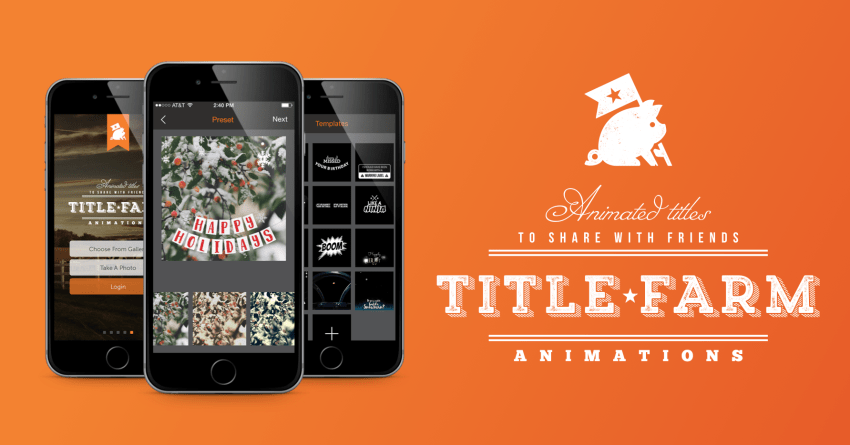As we enter another era of “the big shop” with high-budget work going to a handful of facilities and mid-sized studios groping for enough work to keep the lights on, many people are embracing the wisdom of staying small.
But small doesn’t mean slow or lazy. In the case of Wichita-based Justin McClure Creative, it means nimble, maybe even daring.
With just three full-time employees (including its owner), they’ve managed to work for a slew of desirable clients and produce a broad range of quality work. Their Get Your Shit Together (GYST) project went viral earlier this year (within the motion design community) and helped establish them as a funny but serious studio intent on making an impact.
They recently launched a new project, Title Farm, an app for iOS that allows users to add animated graphics to photos. It also lets designers and animators create their own animations and add them to a growing repository of publicly available titles (or keep them private).

One of the animated templates from the Title Farm app
We were interested in learning more about the thinking and the process behind the app. Our interview with Justin McClure is as candid as it is insightful.
Q&A with Justin McClure: Creating Title Farm
Do you guys feel like developing Title Farm was an organic process — following one success/hunch after another until you arrived at the logical conclusion of making an app — or was it a more strategic, top-down process?
Title Farm was certainly an organic process, but the big, hairy, audacious goal has been consistent and strategic. Develop a platform that allows us to expand our creative services as well as our client roster.
Pretty simple idea, not that easy to execute.
Do you feel the industry is shifting? If so, how?
We’ve produced commercials and promos for large national corporations, agencies, and networks since we opened our doors, but you can feel the landscape of the industry changing. The shift over the last several years has included agencies bringing production companies in-house, crowdsourcing creative with prize incentives, and just an influx of designers and animators in the industry.
If your food source is becoming scarce, you need to adapt, migrate or find other means for survival. We wanted to create a platform that would allow us the opportunity to engage with more clients and in a different way, knowing that their budgets could be a fraction of what we typically work with.
So how do we do this and keep the lights on? Smaller bites and a lot of them.
If your food source is becoming scarce, you need to adapt, migrate or find other means for survival.
What if we could offer clients a 5-second commercial, a promotional offer or an animated logo? And what if these animations could play over the top of any photo they choose, allowing them to customize and use that content on a regular basis from their mobile phone? And what if we made this platform free to use, allowing other designers and animators to create content both personally and for paying clients?
That’s how Title Farm was born, but there’s a lot more coming.
On the surface, Title Farm looks pretty similar to other apps that allows users to add animated text over a photo.
There are a lot of apps out there that allow users the ability to add animations or type over a photo or video. Don’t get me wrong, at it’s most basic level Title Farm is exactly that, but there’s several different opportunities on the front end for motion designers.
On one hand, if a user just wanted to create fun animations to share, they can do that. Think Greyscalegorilla 5 second projects — it’s creating fun content that others will see, but also provides an outlet to push yourself to try something different.
On the other hand, there is an opportunity to create custom content for clients. This can come in the form of added value for current clients, or a new way to reach a completely different audience.
Using Title Farm for client work
Either way, our focus is on the creation of custom content, that’s what we do. We didn’t develop a mobile app to animate, we developed a bridge that allows the motion design world to share their work both for fun and for profit.
Did you test the idea with an audience/beta testers as you developed it? If so, how did that inform your process?
We did, but we targeted friends and family members with small businesses that promote their brands via social media.
We presented a lot of ideas and concepts to them. Some of these ideas were even template based, but what we discovered was that these small businesses really wanted content tailored to their brand. They wanted their fonts, their colors, and their logo, along with unlimited access and usage. So, that’s what we focused on.
Did you use motion design to prototype ideas and present them before you ever jumped into coding?
Yes and no. We created more of a higher level concept animation that explained the overall process, as well as finished examples, but not an exact representation of the finished app.

Another Title Farm animation
We coded enough of a beta app to show clients how easy it was to snap a photo, add the custom animation and then post to social media like Instagram and Facebook. Having a promo video is one thing, seeing how people react to the app in action is another.
Speaking of coding: Who coded it? How did you find them?
We like to tinker. We are always experimenting and developing tools that make us more productive, and we like to do this with talented folks that live in our own backyard. This allows us to be in the same room to brainstorm, test, and provide instant feedback. For this particular project, we collaborated with Clutch Studios and Kyle Finley to make Title Farm a reality.

Promo image for Title Farm
Clutch Studios is located here in Wichita and they developed the mobile application, while Kyle developed the API and Title Farm website.
Last year, Kyle helped create our microsite that let users make their own holiday video card by allowing them to choose a song, add a photo, write a personalized message and send to family and friends. Looking back, that project spearheaded the way for Title Farm.
What did you learn from working with developers?
I think the one big takeaway we learned in this process is that interactivity adds several layers of complexity.
As motion designers, we are accustomed to a linear timeline and the basic structure of a story told from start to finish. We create animatics to construct the foundation and then use that as a road map.
When it comes to code, that road map has alternative routes and navigation built in, and when a change occurs it can ultimately cascade throughout the entire programming. What may appear to be a small change could be quite significant and time consuming.
Did you at any point doubt the whole concept?
We built Title Farm first and foremost for us and for our clients. I think if our intention was to create an app for profit with investors and trying to be the next big thing, there might have been a lot of doubts.
It’s not enough these days just to be a designer and animator, you have to be a hybrid.
Knowing that we could personally utilize Title Farm in so many different ways eliminated any fear. I think we had more questions when it came to how the platform would be used by others and what features they might expect to see in this first round.
What was the most difficult aspect of the whole project?
Besides bootstrapping and working around the clock, releasing a minimally viable product is about the scariest part of this whole process.
We have already begun designing and working on updates and features for the next round, but releasing it now gives us valuable feedback. I think feeling vulnerable and excited all at the same time is the best way to explain it.
We recently interviewed Chris Do, founder of Blind. He said:
“The motion industry in general is not moving towards a positive place. There’s downward pressure from agencies to produce work for less money. There are more and more companies popping up, so I feel that the market is very saturated. This means that supply is far outstripping demand.”
What do you think about the future of motion design?
In addition to my earlier comments, I feel that there are about 5% of artists or studios out there that are the cream of crop. They will always be inundated with work and be paid a premium for their services.
For the rest of us, we’re going to have to learn to adapt to our surroundings to survive. It’s not enough these days just to be a designer and animator, you have to be a hybrid. You have to possess the ability to incorporate the latest technology in everything you do.
When I review portfolios for a possible hire, my first question usually involves their knowledge base on virtual and augmented reality, projection mapping, code, sensors, and on top of that, the ability to think.
Like Chris said, the market is saturated, you have to bring something new to the table if you want to make it in this industry.










